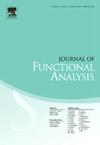Isoperimetric problem and structure at infinity on Alexandrov spaces with nonnegative curvature
IF 1.7
2区 数学
Q1 MATHEMATICS
引用次数: 0
Abstract
In this paper we consider nonnegatively curved finite dimensional Alexandrov spaces with a non-collapsing condition, i.e., such that unit balls have volumes uniformly bounded from below away from zero. We study the relation between the isoperimetric profile, the existence of isoperimetric sets, and the asymptotic structure at infinity of such spaces.
In this setting, we prove that the following conditions are equivalent: the space has linear volume growth; it is Gromov–Hausdorff asymptotic to one cylinder at infinity; it has uniformly bounded isoperimetric profile; the entire space is a tubular neighborhood of either a line or a ray.
Moreover, on a space satisfying any of the previous conditions, we prove existence of isoperimetric sets for sufficiently large volumes, and we characterize the geometric rigidity at the level of the isoperimetric profile.
Specializing our study to the 2-dimensional case, we prove that unit balls have always volumes uniformly bounded from below away from zero, and we prove existence of isoperimetric sets for every volume, characterizing also their topology when the space has no boundary.
The proofs exploit a variational approach, and in particular apply to Riemannian manifolds with nonnegative sectional curvature and to Euclidean convex bodies. Up to the authors' knowledge, most of the results are new even in these smooth cases.
非负曲率Alexandrov空间无穷远处的等周问题和结构
本文考虑具有非坍缩条件的非负弯曲有限维Alexandrov空间,即,使得单位球的体积从下到离零有均匀界。研究了等距轮廓、等距集合的存在性和无穷远处的渐近结构之间的关系。在这种情况下,我们证明了以下条件是等价的:空间具有线性体积增长;在无穷远处Gromov-Hausdorff渐近于一个柱面;它具有均匀有界等周轮廓;整个空间是一条线或一条射线的管状邻域。此外,前面的空间满足任何条件下,我们证明存在足够大的等周集卷,我们描述几何刚度的等周的概要文件。我们专门研究了二维情况,证明了单位球总是有从下到零的均匀边界的体积,并证明了每个体积的等周集的存在性,并刻画了它们在空间无边界时的拓扑结构。证明利用变分方法,特别适用于非负截面曲率的黎曼流形和欧几里得凸体。据作者所知,即使在这些光滑的情况下,大多数结果也是新的。
本文章由计算机程序翻译,如有差异,请以英文原文为准。
求助全文
约1分钟内获得全文
求助全文
来源期刊
CiteScore
3.20
自引率
5.90%
发文量
271
审稿时长
7.5 months
期刊介绍:
The Journal of Functional Analysis presents original research papers in all scientific disciplines in which modern functional analysis plays a basic role. Articles by scientists in a variety of interdisciplinary areas are published.
Research Areas Include:
• Significant applications of functional analysis, including those to other areas of mathematics
• New developments in functional analysis
• Contributions to important problems in and challenges to functional analysis

 求助内容:
求助内容: 应助结果提醒方式:
应助结果提醒方式:


